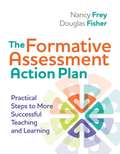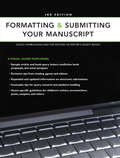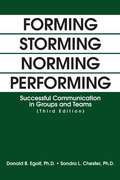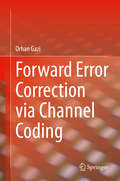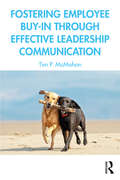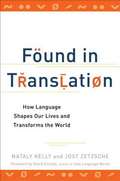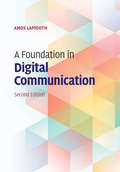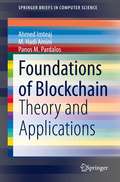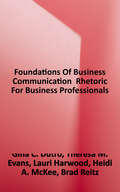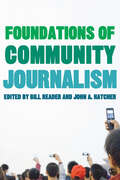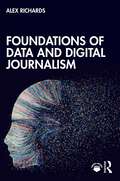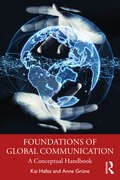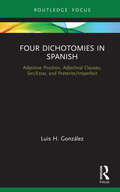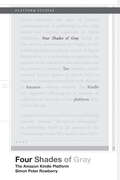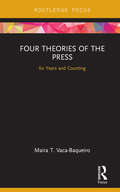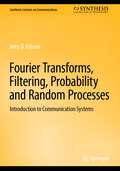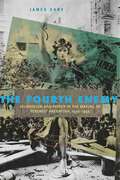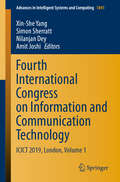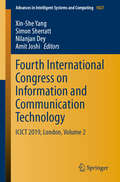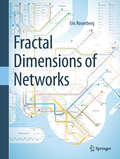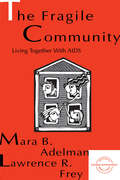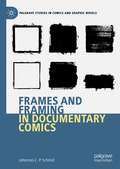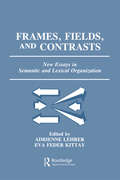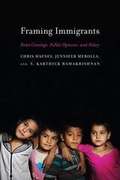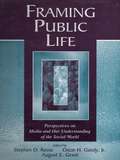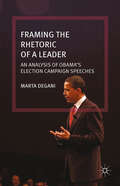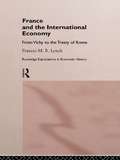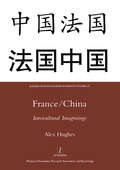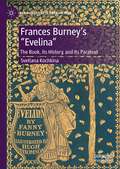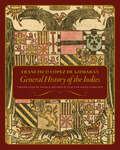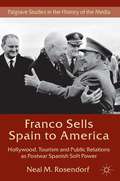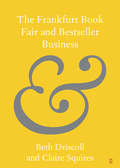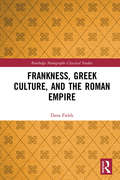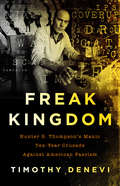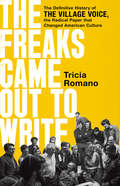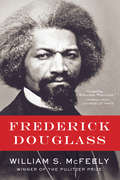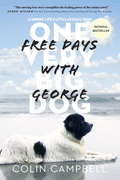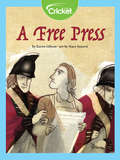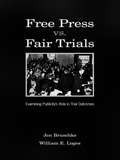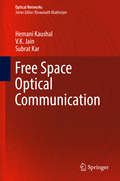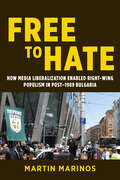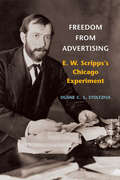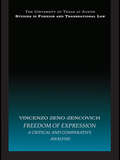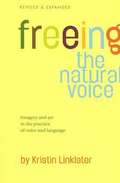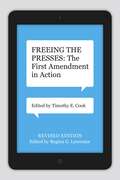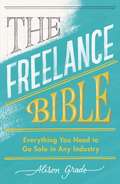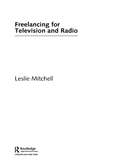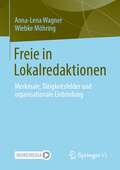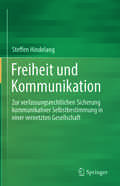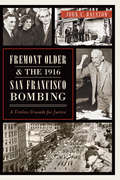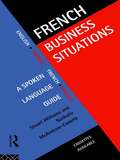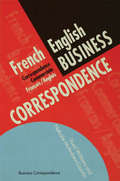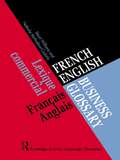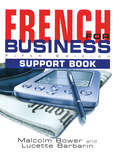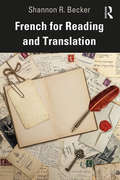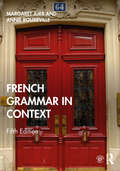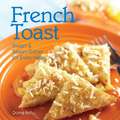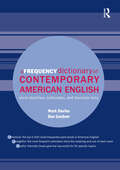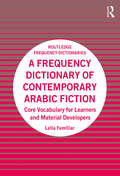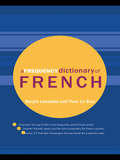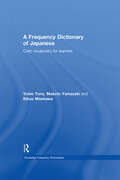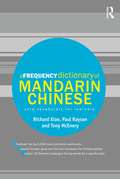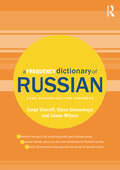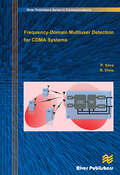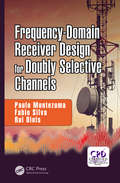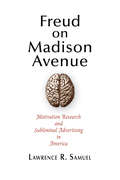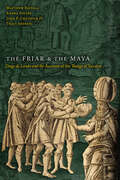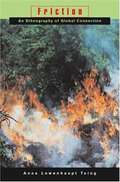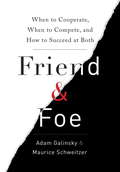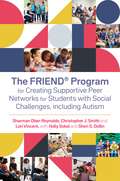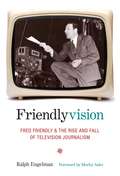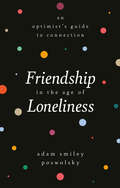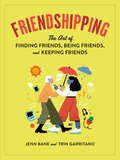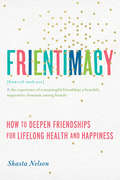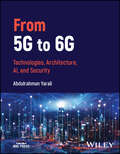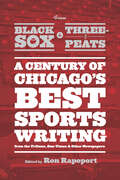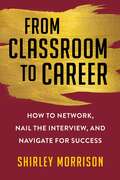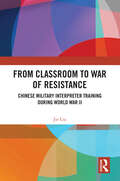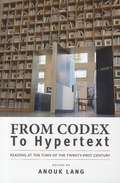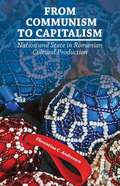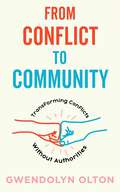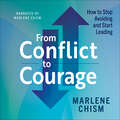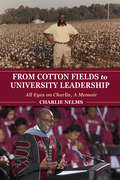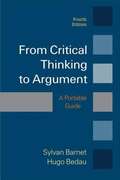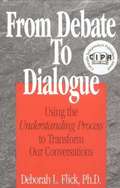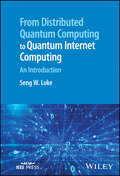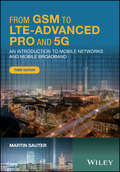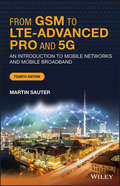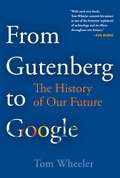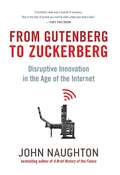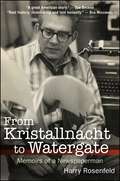The Formative Assessment Action Plan: Practical Steps to More Successful Teaching and Learning (Professional Development)
by Nancy Frey Douglas FisherWinner of a 2012 Distinguished Achievement Award from the Association of Educational Publishers! Join Nancy Frey and Douglas Fisher as they outline a clear-cut, realistic, and rewarding approach to formative assessment. They explain how four discrete steps work in tandem to create a seamless, comprehensive formative assessment system one that has no beginning and no end. This ongoing approach enhances an active give-and-take relationship between teachers and students to promote learning. <p><p> Dozens of real-life scenarios demonstrate how to apply these steps in your classroom, always focusing on the presence or absence of student learning to guide the action. By enabling teachers and students alike to see more clearly what they need to do for learning to be successful, this approach builds students' competence, confidence, and understanding. <p><p> No matter what grade level you teach, The Formative Assessment Action Plan will help you make better use of assessment data so you can more quickly adjust instruction to keep every student on the path to success.
Formatting & Submitting Your Manuscript
by Chuck SambuchinoPrepare and Present Your Work Like a Pro! Formatting & Submitting Your Manuscript, 3rd edition, gives you all the information you need to craft a winning submission. Fully updated, this comprehensive resource now features more than 100 sample letters and manuscript pages, expanded instruction for electronic submissions, updated formatting and submitting guidelines, and new insider tips from top agents and editors. With strong and weak sample query letters, novel synopses, articles, nonfiction book proposals, manuscript pages, scripts, and more, you'll see exactly what works and what doesn't. Plus, each sample page features individual callouts to clearly identify and explain critical elements so that you don't miss a thing. With this all-encompassing guide, you'll discover everything you need to make your work look professional, polished, and publishable.
Forming Storming Norming Performing: Successful Communication In Groups And Teams
by Donald Egolf Sondra ChesterThe purpose of this book is to provide an introduction to Group and Team Communication. Emphasis is placed on giving readers guidelines for becoming successful communicators in groups and teams. Specific emphasis is placed on general introductory concepts, verbal and nonverbal communication, listening, conflict, problem solving, idea generation, decision making, e-collaboration, group presentations, leadership, leadership and power, and performance evaluations.
Forward Error Correction via Channel Coding
by Orhan GaziThis book provides a comprehensive explanation of forward error correction, which is a vital part of communication systems. The book is written in such a way to make the subject easy and understandable for the reader. The book starts with a review of linear algebra to provide a basis for the text. The author then goes on to cover linear block codes, syndrome error correction, cyclic codes, Galois fields, BCH codes, Reed Solomon codes, and convolutional codes. Examples are provided throughout the text.
Fostering Employee Buy-in Through Effective Leadership Communication
by Tim P. McMahonBased on a case study of leadership communication in a time of organizational change, this book gives new leaders insights into the tools and skills needed to become effective, motivating communicators in their leadership careers. Taking a holistic approach to communication and leadership, the book argues that employees buy in to change when they collectively feel engaged in meaningful work that will enrich the lives of customers, employees, and investors. Based on ethnographic research, it approaches the topic through an absorbing fiction-like retelling of an organization’s successful navigation of change against the backdrop of the 2007 mortgage crisis. In doing so, it establishes a framework for leaders to understand the principles behind how and why buy-in is generated in organizations. This unique approach allows readers to visualize leadership communication principles in practice. Fostering Employee Buy-in is ideal as a supplementary text in introductory leadership communication, management, and business courses or as a text for new leaders interested in inspiring organizational change.
Found in Translation: How Language Shapes Our Lives and Transforms the World
by Nataly Kelly Jost ZetzscheA lively look at the surprising role that translation plays all around us. Worth an estimated 31 billion dollars, translation is one of the biggest industries that goes largely unnoticed. Nataly Kelly and Jost Zetzsche are two veteran translators who have show how translation affects the daily life of millions of people. From hurricane warnings to holy books, from poetry to peace treaties, this is an illustration of how translation spreads culture and fuels the global economy.
A Foundation In Digital Communication
by Amos LapidothThis intuitive yet rigorous introduction derives the core results of digital communication from first principles. Theory, rather than industry standards, motivates the engineering approaches, and key results are stated with all the required assumptions. The book emphasizes the geometric view, opening with the inner product, the matched filter for its computation, Parseval's theorem, the sampling theorem as an orthonormal expansion, the isometry between passband signals and their baseband representation, and the spectral-efficiency optimality of quadrature amplitude modulation (QAM). Subsequent chapters address noise, hypothesis testing, Gaussian stochastic processes, and the sufficiency of the matched filter outputs. Uniquely, there is a treatment of white noise without generalized functions, and of the power spectral density without artificial random jitters and random phases in the analysis of QAM. This systematic and insightful book, with over 300 exercises, is ideal for graduate courses in digital communication, and for anyone asking 'why' and not just 'how'.
Foundations in Written Communication
by Brian Gogan S. Atkins I. Atkinson K. Mitchell E. Spinner S. XaverThis text will be foundational to your work in written communication, upon which many of your other college classes and perhaps even your career will build. This text will provide you, your classmates, and your instructor with the metaphorical cornerstone of your foundation in written communication, as it will offer and explain various writing, reading, and research strategies that you can use to become a more successful writer. In each chapter of this book, you will encounter a significant number of writing strategies. These strategies are presented to you in a way that is both highly practical--in many cases, a series of step-by-step instructions and examples are provided for you to thoroughly explain each strategy-- and also theoretical--in all cases, the strategies emerge from rich theories of writing, including some innovative approaches to the teaching of writing. Among these strategies, you can expect to find a series of invention activities, which will help you to conceptualize your ideas about writing and generate material for your writing. Some of these strategies can be categorized as aleatory procedures because they embrace chance. Some of these strategies can be categorized as heuristic procedures because they encourage problem-solving. And, a final group of these procedures can be categorized as algorithms as they work with models and formulas. Together, these invention strategies will jumpstart your writing work.
Foundations of Blockchain: Theory and Applications (SpringerBriefs in Computer Science)
by Ahmed Imteaj M. Hadi Amini Panos M. PardalosThis book provides a comprehensive analysis of fundamental topics related to blockchain. Throughout, the authors explore different vital issues and specific areas of blockchain. For convenience, the authors present the elementary description, visualize the working procedure of blockchain paradigm, and highlight the areas it can be applied in real life. They explain the blockchain process from a diverse perspective i.e. distributed Internet of Things (IoT), interdependent networks, intelligent mining, etc. They also analyze the interconnection of a blockchain network and such novel research areas to show a pathway towards a new research direction. This book also holds the core challenges and open research issues of blockchain technology, considering existing applications. Chapters include consensus mechanisms of blockchain, blockchain applicability in centralized and decentralized internet of things, blockchain interoperability from the perspective of interdependent networks, and blockchain for resource-constrained devices.Specifies the importance of theoretical methods in dealing with problems in the context of blockchain for interdependent decision making;Provides a comprehensive investigation of blockchain algorithms and the recently developed methods based on this algorithm;Provides basics and mathematical foundations needed to learn and deploy blockchain.
Foundations of Business Communication: Rhetoric for Business Professionals
by Gina C. Dutro Theresa M. Evans Lauri Harwood Heidi A. McKee Brad ReitzFoundations of Business Communication: Rhetoric for Business Professionals, was written by the faculty of BUS 102 to provide a resource to help you in BUS 102, in your other FSB courses, and in your professional career. - Chapter 2: Business Communication Today explains the importance of effective communication in today's globally networked workplace and defines the characteristics of effective business communication. - Chapter 3: Rhetoric in Business Communication introduces the key concepts and strategies of rhetoric, the art and practice of effective communication. You will learn how to analyze the rhetorical situation of business communication so that you can craft effective messages appropriate for your purpose, audience, and context. - Chapter 4: Delivering Oral Communications examines the rhetoric of oral delivery, strategies for organizing oral communications, and design tips for presentation visuals. The primary focus is on extemporaneous presentations, but oral communications in other business contexts are also considered. - Chapter 5: Developing Business Relationships explains how to introduce yourself within business communities and how to frame requests that establish goodwill with your audience(s). This chapter also has tips for writing business emails. - Chapter 6: Business Communication Processes provides guidelines for the composing process for a variety of oral and written communications. - Chapter 7: Planning for the Job Search offers an overview of the job search communication process, from locating position announcements and networking to interviewing and job acceptance communications. - Chapter 8: Writing Cover Letters has information and advice on how to write a cover letter that will stand out to prospective employers. The assignment scenario focuses on opportunities available to early career college students, and from this project many students have found excellent summer internships and jobs. - Chapter 9: Collaborating and Communicating as a Team builds from the work on collaboration begun in BUS 101 and delves into the specifics of how to research, write, and present as a team. - Chapter 10: Reporting Your Findings examines the structure of formal recommendation reports and provides foundational strategies for how to narrate and represent qualitative and quantitative data. - Chapter 11: Making Recommendations explains how to deliver credible recommendations in writing and orally that are clear, concise, and thorough. - Chapter 12: Looking Back, Moving Forward covers the importance of reflective analysis for transferring learning from your first-year experiences into FSB's upper division core and major courses and on into your professional careers.
Foundations of Community Journalism
by Reader, Bill and Hatcher, John A.Foundations of Community Journalism is the first and only book to focus on how to understand and conduct research in this ever-increasing field. With chapters written by established journalism scholars and teachers, this book provides students and researchers with an understanding of the multiple methods applied to the study of community journalism, such as historical, social-scientific, cultural/critical, and interdisciplinary approaches. It explains what community journalism is as a research concept and offers a range of different methods and theories that can be applied to community journalism research. Although there are numerous "how-to" community journalism manuals for students and newspaper editors, none focuses on how to conduct research into community journalism. The body of knowledge in Foundations of Community Journalism would take readers months, perhaps years, of independent work to gather, making this book a "must-have" volume and reference tool for anybody who is interested in the relationships between journalism and communities.
Foundations of Data and Digital Journalism
by Alex RichardsThis accessible, step-by-step guide is written for students and working professionals who want to better understand data journalism, web design, and the visualization of information. Foundations of Data and Digital Journalism recognizes a growing need for general data knowledge in newsrooms across the globe, including an understanding of what’s possible for both data reporting and presentation and how it can be achieved. It serves as a roadmap for students and working journalists who seek to understand what data is and how to find it; how to harness it most effectively for news; how to think critically about analysis results, potential shortcomings in the data, and the inclusion of appropriate context; and how to present compelling, data-driven stories online. Interviews with a diverse range of current practitioners help the reader gain a deeper understanding of how these tools and techniques are used in digitally focused newsrooms today. Taking a holistic approach to data journalism, this book enables readers to: ● Assess a data set with a critical eye, understanding what it shows, how it was created, and for what purpose. ● Master prominent and easily accessible software tools, including Google Sheets and R. ● Translate findings and conclusions into plain English for a news audience without overstating what the data can show or being misleading. ● Create impactful, attractive visualizations for an audience to explore. ● Understand how the modern web works, including HTML5, CSS3, and responsive webpage frameworks, like Bootstrap. This is an ideal textbook for undergraduate and postgraduate journalism students and for working professionals looking to expand their skillset. The book is supported with online student resources, including example datasets to support the material covered, available at Routledge.com.
Foundations of Global Communication: A Conceptual Handbook
by Kai Hafez Anne GrüneThis book provides a wide-ranging theoretical and empirical overview of the disparate achievements and shortcomings of global communication. This exceptionally ambitious and systematic project takes a critical perspective on the globalization of communication. Uniquely, it sets media globalization alongside a plethora of other globalized forms of communication, ranging from the individual to groups, civil society groupings, commercial enterprises and political formations. The result is a sophisticated and impressive overview of globalized communication across various facets, assessing the phenomena for the extent to which they live up to the much-hyped claims of globalization’s potential to create a globally interdependent society. The setbacks of globalization, such as right-wing populism and religious fundamentalism, can only be understood if the shortcomings of global communication are taken more seriously. Covering all types of cross-border global communication in media, political and economic systems, civil societies, social media and lifeworlds of the individual, this unique book is invaluable for students and researchers in media, communication, globalization and related areas.
Four Dichotomies in Spanish: Adjective Position, Adjectival Clauses, Ser/Estar, and Preterite/Imperfect
by Luis H. GonzálezExamining four dichotomies in Spanish, this book shows how to reduce the six to ten rules common in textbooks for each contrast to a single binary distinction. That distinction is a form of totality vs. part, easier to see in some of the dichotomies, but present in all of them. Every chapter is example-driven, and many of those examples come from writing by students. Readers can test out for themselves the explanation at work in the examples provided. Then, those examples are explained step by step. In addition to examples from writing by college students, there are examples from RAE (Real Academia Española), from scholars, from writers, from Corpes XXI (RAE), from the Centro Virtual Cervantes, and from the Internet. Many of those examples are presented to the reader as exercises, and answers are provided. This book was written for teachers of Spanish as a second language (L2) and for minors or majors of Spanish as an L2. It will also benefit teachers and learners of other L2s with some of these dichotomies.
Four Shades of Gray: The Amazon Kindle Platform (Platform Studies)
by Simon Peter RowberryThis first book-length analysis of Amazon&’s Kindle explores the platform&’s technological, bibliographical, and social impact on publishing.Four Shades of Gray offers the first book-length analysis of Amazon&’s Kindle and its impact on publishing. Simon Peter Rowberry recounts how Amazon built the infrastructure for a new generation of digital publications, then considers the consequences of having a single company control the direction of the publishing industry. Exploring the platform from the perspectives of technology, texts, and uses, he shows how the Kindle challenges traditional notions of platforms as discrete entities. He argues that Amazon&’s influence extends beyond &“disruptive technology&” to embed itself in all aspects of the publishing trade; yet despite industry pushback, he says, the Kindle has had a positive influence on publishing. Rowberry documents the first decade of the Kindle with case studies of Kindle Popular Highlights, an account of the digitization of books published after 1922, and a discussion of how Amazon&’s patent filings reflect a shift in priorities. Rowberry argues that while it was initially convenient for the book trade to outsource ebook development to Amazon, doing so has had adverse consequences for publishers in the mid- and long term, limiting opportunities for developing an inclusive and forward-thinking digital platform. While it has forced publishers to embrace digital forms, the Kindle has also empowered some previously marginalized readerships. Although it is still too early to judge the long-term impact of ebooks compared with that of the older technologies of clay tablets, the printing press, and offset printing, the shockwaves of the Kindle continue to shape publishing.
Four Theories of the Press: 60 Years and Counting
by Maira T. Vaca-BaqueiroThe links between distinctive political regimes and media systems are undeniable. As Siebert, Peterson and Schramm wrote (1956: 1) 60 years ago: ‘the press always takes on the form and coloration of the social and political structures within which it operates’. Nevertheless, today’s world and politics are completely different from the bipolar era that inspired the ground breaking Four Theories of the Press. What are the main changes and continuities that have driven the study of politics and the media in the last decades? How to approach this interaction in the light of the challenges that democracy is facing or the continuing technological revolution that at times hampers the media?This provocative book explores the main premises that have guided the study of politics and the media in the last decades. In so doing, it gives the reader key analytical tools to question the sustainability of past categorizations that no longer match up with current developments of both, political regimes and the media. In searching for clarification about current discrepancies between democracies and media’s distinctive structures or purposes, Four Theories of the Press: 60 Years and Counting puts forward an alternative premise: the political-media complex.
Fourier Transforms, Filtering, Probability and Random Processes: Introduction to Communication Systems (Synthesis Lectures on Communications)
by Jerry D. GibsonThis book provides backgrounds and the mathematical methods necessary to understand the basic transforms in signal processing and linear systems to prepare for in depth study of analog and digital communications systems.This tutorial presentation provides developments of Fourier series and other orthogonal series, including trigonometric and complex exponential Fourier series, least squares approximations and generalized Fourier series, and the spectral content of periodic signals. This text thoroughly covers Fourier transform pairs for continuous time signals, Fourier transform properties, and the magnitude and phase of Fourier transforms. The author includes discussions of techniques for the analysis of continuous time linear systems in the time and frequency domains with particular emphasis on the system transfer function, impulse response, system/filter bandwidth, power and energy calculations, and the time domain sampling theorem.
The Fourth Enemy: Journalism and Power in the Making of Peronist Argentina, 1930–1955
by James CaneThe rise of Juan Perón to power in Argentina in the 1940s is one of the most studied subjects in Argentine history. But no book before this has examined the role the Peronists’ struggle with the major commercial newspaper media played in the movement’s evolution, or what the resulting transformation of this industry meant for the normative and practical redefinition of the relationships among state, press, and public. In The Fourth Enemy, James Cane traces the violent confrontations, backroom deals, and legal actions that allowed Juan Domingo Perón to convert Latin America’s most vibrant commercial newspaper industry into the region’s largest state-dominated media empire. An interdisciplinary study drawing from labor history, communication studies, and the history of ideas, this book shows how decades-old conflicts within the newspaper industry helped shape not just the social crises from which Peronism emerged, but the very nature of the Peronist experiment as well.
The Fourth Enemy: Journalism and Power in the Making of Peronist Argentina, 1930–1955
by James CaneThe rise of Juan Perón to power in Argentina in the 1940s is one of the most studied subjects in Argentine history. But no book before this has examined the role the Peronists’ struggle with the major commercial newspaper media played in the movement’s evolution, or what the resulting transformation of this industry meant for the normative and practical redefinition of the relationships among state, press, and public. In The Fourth Enemy, James Cane traces the violent confrontations, backroom deals, and legal actions that allowed Juan Domingo Perón to convert Latin America’s most vibrant commercial newspaper industry into the region’s largest state-dominated media empire. An interdisciplinary study drawing from labor history, communication studies, and the history of ideas, this book shows how decades-old conflicts within the newspaper industry helped shape not just the social crises from which Peronism emerged, but the very nature of the Peronist experiment as well.
Fourth International Congress on Information and Communication Technology: ICICT 2019, London, Volume 1 (Advances in Intelligent Systems and Computing #1041)
by Xin-She Yang Nilanjan Dey Amit Joshi Simon SherrattThis book gathers selected high-quality research papers presented at the Fourth International Congress on Information and Communication Technology, held at Brunel University, London, on February 27–28, 2019. It discusses emerging topics pertaining to information and communication technology (ICT) for managerial applications, e-governance, e-agriculture, e-education and computing technologies, the Internet of things (IoT), and e-mining. Written by respected experts and researchers working on ICT, the book offers a valuable asset for young researchers involved in advanced studies.
Fourth International Congress on Information and Communication Technology: ICICT 2019, London, Volume 2 (Advances in Intelligent Systems and Computing #1027)
by Xin-She Yang Simon Sherratt Nilanjan Dey Amit JoshiThe second volume of this book includes selected high-quality research papers presented at the Fourth International Congress on Information and Communication Technology, which was held at Brunel University, London, on February 27–28, 2019. It discusses emerging topics pertaining to information and communication technology (ICT) for managerial applications, e-governance, e-agriculture, e-education and computing technologies, the Internet of Things (IoT), and e-mining. Written by respected experts and researchers actively working in ICT, the book offers a valuable resource, especially for researchers who are newcomers to the field.
Fractal Dimensions of Networks (Springerbriefs In Computer Science Ser.)
by Eric RosenbergCurrent interest in fractal dimensions of networks is the result of more than a century of previous research on dimensions. Fractal Dimensions of Networks ties the theory and methods for computing fractal dimensions of networks to the “classic” theory of dimensions of geometric objects.The goal of the book is to provide a unified treatment of fractal dimensions of sets and networks. Since almost all of the major concepts in fractal dimensions originated in the study of sets, the book achieves this goal by first clearly presenting, with an abundance of examples and illustrations, the theory and algorithms for sets, and then showing how the theory and algorithms have been applied to networks. Thus, the book presents the classical theory and algorithms for the box counting dimension for sets, and then presents the box counting dimension for networks. All the major fractal dimensions are studied, e.g., the correlation dimension, the information dimension, the Hausdorff dimension, the multifractal spectrum, as well as many lesser known dimensions. Algorithm descriptions are accompanied by worked examples, many applications of the methods are presented, and many exercises, ranging in difficulty from easy to research level, are included.
The Fragile Community: Living Together With Aids (Everyday Communication Ser.)
by Mara B. Adelman Larry R. FreyThis book examines the concept of "community," focusing on how communication practices help manage the tensions of creating and sustaining everyday communal life amidst the crisis of human loss. While acknowledging how the contradictory and inconsistent nature of human relationships inevitably affects community, this intimate and compelling text shows how community is created and sustained in concrete communication practices. The authors explore these ideas at Bonaventure House, an award-winning residential facility for people with AIDS, where the web of social relationships and the demands of a life-threatening illness intersect in complex ways. Facing a life-threatening illness can defy meaningful social connections, but it can also inspire such ties, sometimes in ways that elude us in the course of daily life. By understanding how collective communication practices help residents forge a sense of community out of the fragility and chaos of living together with AIDS, we are able to better understand how communication is inexorably intertwined with the formation of community in other environments. Based on seven years of ethnographic research including participant-observation, in-depth interviews, and questionnaires, this book weaves together narratives and visual images with conceptual analysis to uncover the ongoing oppositional forces of community life, and to show how both mundane and profound communication processes ameliorate these tensions, and thereby sustain this fragile community. Because the average length of stay for a resident is seven months -- in which time he or she moves from being a newcomer to a community member to someone the community remembers -- the text reflects this short, but crystallized life, starting with the day a new resident opens the door to the day he or she passes away. The writing is rich -- intimate, engaging, personal, compelling, and vivid. The stories told discuss such deeply personal topics as the dilemmas of romantic relationships in a context fraught with many perils; issues of power, authority, and control that enable and constrain social life; and communicative practices that help residents cope with bereavement over the loss of others as well as their own impending deaths. The text concludes by examining the lessons learned from Bonaventure House about creating and sustaining a health community, and serves as an inspiration for strengthening interpersonal relationships and communities in other environments.
Frames and Framing in Documentary Comics (Palgrave Studies in Comics and Graphic Novels)
by Johannes C.P. SchmidFrames and Framing in Documentary Comics explores how graphic narratives reframe global crises while also interrogating practices of fact-finding. An analog print phenomenon in an era shaped by digitalization, documentary comics formulates a distinct counterapproach to conventional journalism. In what ways are ‘facts’ being presented and framed? What is documentary honesty in a world of fake news and post-truth politics? How can the stories of marginalized peoples and neglected crises be told? The author investigates documentary comics in its unique relationship to framing: graphic narratives are essentially shaped by a reciprocal relationship between the manifest frames on the page and the attention to the cognitive frames that they generate. To account for both the textuality of comics and its strategic use as rhetoric, the author combines theories of framing analysis and cognitive narratology with comics studies and its attention toward the medium’s visual frames.
Frames, Fields, and Contrasts: New Essays in Semantic and Lexical Organization
by Adrienne Lehrer Eva Feder KuttayRecently, there has been a surge of interest in the lexicon. The demand for a fuller and more adequate understanding of lexical meaning required by developments in computational linguistics, artificial intelligence, and cognitive science has stimulated a refocused interest in linguistics, psychology, and philosophy. Different disciplines have studied lexical structure from their own vantage points, and because scholars have only intermittently communicated across disciplines, there has been little recognition that there is a common subject matter. The conference on which this volume is based brought together interested thinkers across the disciplines of linguistics, philosophy, psychology, and computer science to exchange ideas, discuss a range of questions and approaches to the topic, consider alternative research strategies and methodologies, and formulate interdisciplinary hypotheses concerning lexical organization. The essay subjects discussed include: * alternative and complementary conceptions of the structure of the lexicon, * the nature of semantic relations and of polysemy, * the relation between meanings, concepts, and lexical organization, * critiques of truth-semantics and referential theories of meaning, * computational accounts of lexical information and structure, and * the advantages of thinking of the lexicon as ordered.
Frameworks: An Introduction to Film Studies
by Thomas E. Valasek F. Brent Johnson Christopher H. CreekFrameworks sets out to teach both the concepts and the skills beginning students need to become more literate film viewers. Lessons are designed to answer four essential questions: How do films tell a story? How do films reveal characters? How do films depict physical reality? How do films inform, persuade, and indoctrinate? Each of these questions offers a different "framework" for film study, a different way to look at and analyze film.
Framing Immigrants: News Coverage, Public Opinion, and Policy
by Chris Haynes Jennifer Merolla S. Karthick RamakrishnanWhile undocumented immigration is controversial, the general public is largely unfamiliar with the particulars of immigration policy. Given that public opinion on the topic is malleable, to what extent do mass media shape the public debate on immigration? In Framing Immigrants, political scientists Chris Haynes, Jennifer Merolla, and Karthick Ramakrishnan explore how conservative, liberal, and mainstream news outlets frame and discuss undocumented immigrants. Drawing from original voter surveys, they show that how the media frames immigration has significant consequences for public opinion and has implications for the passage of new immigration policies. The authors analyze media coverage of several key immigration policy issues—including mass deportations, comprehensive immigration reform, and measures focused on immigrant children, such as the DREAM Act—to chart how news sources across the ideological spectrum produce specific “frames” for the immigration debate. In the past few years, liberal and mainstream outlets have tended to frame immigrants lacking legal status as “undocumented” (rather than “illegal”) and to approach the topic of legalization through human-interest stories, often mentioning children. Conservative outlets, on the other hand, tend to discuss legalization using impersonal statistics and invoking the rule of law. Yet, regardless of the media’s ideological positions, the authors’ surveys show that “negative” frames more strongly influence public support for different immigration policies than do positive frames. For instance, survey participants who were exposed to language portraying immigrants as law-breakers seeking “amnesty” tended to oppose legalization measures. At the same time, support for legalization was higher when participants were exposed to language referring to immigrants living in the United States for a decade or more. Framing Immigrants shows that despite heated debates on immigration across the political aisle, the general public has yet to form a consistent position on undocumented immigrants. By analyzing how the media influences public opinion, this book provides a valuable resource for immigration advocates, policymakers, and researchers.
Framing Public Life: Perspectives on Media and Our Understanding of the Social World (Routledge Communication Series)
by Stephen D. Reese Oscar H. Gandy Jr. August E. GrantThis distinctive volume offers a thorough examination of the ways in which meaning comes to be shaped. Editors Stephen Reese, Oscar Gandy, and August Grant employ an interdisciplinary approach to the study of conceptualizing and examining media. They illustrate how texts and those who provide them powerfully shape, or "frame," our social worlds and thus affect our public life. Embracing qualitative and quantitative, visual and verbal, and psychological and sociological perspectives, this book helps media consumers develop a multi-faceted understanding of media power, especially in the realm of news and public affairs.
Framing the Rhetoric of a Leader: An Analysis of Obama’s Election Campaign Speeches
by M. DeganiBased on a selection of 30 election campaign speeches during Obama's first run for the American presidency in 2008, this book investigates the Democratic presidential candidate's much celebrated rhetoric from a cognitive semantics point of view.
France and the International Economy: From Vichy to the Treaty of Rome (Routledge Explorations in Economic History)
by Frances LynchThis is a comprehensive history of a critically formative period in French economic history. Frances Lynch covers topics such as the post-war negotiations for American aid, the reconstruction of a capital market, the modernization of French agriculture, the liberalization of trade in the 1950s and subsequent economic growth.
France/China: Intercultural Imaginings
by Alex HughesChina has long been an object of fascination for the French, who celebrated theirannee de la Chine in 2004. Symptomatic of that fascination are the movements into China made by groups as diverse as the Jesuits, who arrived inL'Empire du Milieu in the late seventeenth century, and theTel Quel intellectuals, whose will to political pilgrimage took th
Frances Burney’s “Evelina”: The Book, its History, and its Paratext (New Directions in Book History)
by Svetlana KochkinaEvelina, the first novel by Frances Burney, published in 1778, enjoys lasting popularity among the reading public. Tracing its publication history through 174 editions, adaptations, and reprints, many of them newly discovered and identified, this book demonstrates how the novel’s material embodiment in the form of the printed book has been reshaped by its publishers, recasting its content for new generations of readers. Four main chapters vividly describe how during 240 years, Evelina, a popular novel of manners, metamorphosed without any significant alterations to its text into a Regency “rambling” text, a romantic novel for “lecteurs délicats,” a cheap imprint for circulating libraries, a yellow-back, a book with a certain aesthetic cachet, a Christmas gift-book, finally becoming an integral part of the established literary canon in annotated scholarly editions. This book also focuses on the remodelling and transformation of the paratext in this novel, written by a woman author, by the heavily male-dominated publishing industry. Shorter Entr’acte sections discuss and describe alterations in the forms of Burney’s name and the title of her work, the omission and renaming of her authorial prefaces, and the redeployment of the publisher’s prefatorial apparatus to support particular editions throughout almost two-and-a-half centuries of the novel’s existence. Illustrated with reproductions of covers, frontispieces, and title pages, the book also provides an illuminating insight into the role of Evelina’s visual representation in its history as a marketable commodity, highlighting the existence of editions targeting various segments of the book market: from the upper-middle-class to mass-readership. The first comprehensive and fully updated bibliography of English and translated editions, adaptations, and reprints of Evelina published in 13 languages and scripts appears in an appendix.
Francisco López de Gómara's General History of the Indies
by Angela Helmer Clayton Miles LehmannThis work is the first English translation of the entire text of part one of sixteenth-century Spanish historian Francisco López de Gómara’s General History of the Indies. Including substantial critical annotations and providing access to various readings and passages added to or removed from the successive editions of the 1550s, this translation expands the archive of texts available to English speakers reconsidering the various aspects of the European invasion of America. General History of the Indies was the first universal history of the recent discoveries and conquests of the New World made available to the Old World audience. At publication it consisted of two parts: the first a general history of the European discovery, conquest, and settlement of the Americas, and the second a detailed description of Cortés’s conquest of Mexico. Part one—in the multiple Spanish editions and translations into Italian and French published at the time—was the most comprehensive, popular, and accessible account of the natural history and geography of the Americas, the ethnology of the peoples of the New World, and the history of the Spanish conquest, including the most recent developments in Peru. Despite its original and continued importance, however, it had never been translated into English. Gómara’s history communicates Europeans’ general understanding of the New World throughout the middle and later sixteenth century. A lively, comparatively brief description of Europe’s expansion into the Americas with significant importance to today’s understanding of the early modern worldview, Francisco López de Gómara’s General History of the Indies will be of great interest to students of and specialists in Latin American history, Latin American literature, anthropology, and cultural studies, as well as specialists in Spanish American intellectual history and colonial Latin America.
Franco Sells Spain to America
by Neal M. RosendorfA groundbreaking study of the Franco regime's utilization of Hollywood film production in Spain, American tourism, and sophisticated public relations programs - including the most popular national pavilion at the 1964-65 New York World's Fair - in a determined effort to remake the Spanish dictatorship's post-World War II reputation in the US.
The Frankfurt Book Fair and Bestseller Business (Elements in Publishing and Book Culture)
by Beth Driscoll Claire SquiresThe Frankfurt Book Fair is the leading global industry venue for rights sales, facilitating business-to-buzzness deals and international networks. In this Element, we pursue an Ullapoolist approach to excavate beneath the production of bestsellers at the Fair. Our investigation involved three consecutive years of fieldwork (2017–2019) including interviews and autoethnographic, arts-informed interventions. The Element argues that buzz at the Fair exists in two states: as market-ready media reports and partial, lived experiences linked to mood. The physical structures and absences of the Fair enact its power relations and direct the flow of books and buzz. Further, the Fair is not only a site for commercial exchange but a carnival of sorts, marked by disruptive historical events and problematic socio-political dynamics. Key themes emerging from the Element are the presence of excess, the pseudo(neo)liberal self-satisfaction of book culture, and the interplay of optimism and pessimism in contemporary publishing.
Frankness, Greek Culture, and the Roman Empire (Routledge Monographs in Classical Studies)
by Dana FieldsFrankness, Greek Culture, and the Roman Empire discusses the significance of parrhēsia (free and frank speech) in Greek culture of the Roman empire. The term parrhēsia first emerged in the context of the classical Athenian democracy and was long considered a key democratic and egalitarian value. And yet, references to frank speech pervade the literature of the Roman empire, a time when a single autocrat ruled over most of the known world, Greek cities were governed at the local level by entrenched oligarchies, and social hierarchy was becoming increasingly stratified. This volume challenges the traditional view that the meaning of the term changed radically after Alexander the Great, and shows rather that parrhēsia retained both political and ethical significance well into the Roman empire. By examining references to frankness in political writings, rhetoric, philosophy, historiography, biographical literature, and finally satire, the volume also explores the dynamics of political power in the Roman empire, where politics was located in interpersonal relationships as much as, if not more than, in institutions. The contested nature of the power relations in such interactions - between emperors and their advisors, between orators and the cities they counseled, and among fellow members of the oligarchic elite in provincial cities - reveals the political implications of a prominent post-classical intellectual development that reconceptualizes true freedom as belonging to the man who behaves - and speaks - freely. At the same time, because the role of frank speaker is valorized, those who claim it also lay themselves open to suspicions of self-promotion and hypocrisy. This volume will be of interest to students and scholars of rhetoric and political thought in the ancient world, and to anyone interested in ongoing debates about intellectual freedom, limits on speech, and the advantages of presenting oneself as a truth-teller.
Freak Kingdom: Hunter S. Thompson's Manic Ten-Year Crusade Against American Fascism
by Timothy DeneviThe story of Hunter S. Thompson's crusade against Richard Nixon and the threat of fascism in America--and the devastating price he paid for it <P><P>Hunter S. Thompson is often misremembered as a wise-cracking, drug-addled cartoon character. <p><p>This book reclaims him for what he truly was: a fearless opponent of corruption and fascism, one who sacrificed his future well-being to fight against it, rewriting the rules of journalism and political satire in the process. This skillfully told and dramatic story shows how Thompson saw through Richard Nixon's treacherous populism and embarked on a life-defining campaign to stop it. <p><p>In his fevered effort to expose institutional injustice, Thompson pushed himself far beyond his natural limits, sustained by drugs, mania, and little else. For ten years, he cast aside his old ambitions, troubled his family, and likely hastened his own decline, along the way producing some of the best political writing in our history. <p><p>This timely biography recalls a period of anger and derangement in American politics, and one writer with the guts to tell the truth.
The Freaks Came Out to Write: The Definitive History of the Village Voice, the Radical Paper That Changed American Culture
by Tricia RomanoA rollicking history of America's most iconic weekly newspaper told through the voices of its legendary writers, editors, and photographers. You either were there or you wanted to be. A defining New York City institution co-founded by Norman Mailer, The Village Voice was the first newspaper to cover hip-hop, the avant-garde art scene, and Off-Broadway with gravitas. It reported on the AIDS crisis with urgency and seriousness when other papers dismissed it as a gay disease. In 1979, the Voice&’s Wayne Barrett uncovered Donald Trump as a corrupt con artist before anyone else was paying attention. It invented new forms of criticism and storytelling and revolutionized journalism, spawning hundreds of copycats. With more than 200 interviews, including two-time Pulitzer Prize winner, Colson Whitehead, cultural critic Greg Tate, gossip columnist Michael Musto, and feminist writers Vivian Gornick and Susan Brownmiller, former Voice writer Tricia Romano pays homage to the paper that saved NYC landmarks from destruction and exposed corrupt landlords and judges. With interviews featuring post-punk band, Blondie, sportscaster Bob Costas, and drummer Max Weinberg, of Bruce Springsteen&’s E Street Band, in this definitive oral history, Romano tells the story of journalism, New York City and American culture—and the most famous alt-weekly of all time.
Frederick Douglass: Frederick Douglass And Transatlantic Reform (Norton Critical Editions Ser. #0)
by William S. McFeely“A detailed, finely written portrait of the imposing 19th-century leader.” —David Levering Lewis, New York Times Book Review Born into but escaped from slavery, Frederick Douglass—orator, journalist, autobiographer; revolutionary on behalf of a just America—was a towering figure, at once consummately charismatic and flawed. His Narrative of the Life of Frederick Douglass (1845) galvanized the antislavery movement and is one of the truly seminal works of African-American literature. In this Lincoln Prize– winning biography, William S. McFeely captures the many sides of Douglass— his boyhood on the Chesapeake; his self-education; his rebellion and rising expectations; his marriage, affairs, and intense friendships; his bitter defeat and transcendent courage—and re-creates the high drama of a turbulent era.
Free Days With George
by Colin CampbellA heartwarming, true story about George, a rescue dog who helps his owner rediscover love and happiness. Marley & Me meets Tuesdays with Morrie and The Art of Racing in the Rain--get your tissues ready, animal lovers! After Colin Campbell went on a short business trip abroad, he returned home to discover his wife of many years had moved out. No explanations. No second chances. She was gone and wasn't coming back. Shocked and heartbroken, Colin fell into a spiral of depression and loneliness. Soon after, a friend told Colin about a dog in need of rescue--a neglected 140-pound Newfoundland Landseer, a breed renowned for its friendly nature and remarkable swimming abilities. Colin adopted the traumatized dog, brought him home and named him George. Both man and dog were heartbroken and lacking trust, but together, they learned how to share a space, how to socialize, and most of all, how to overcome their bad experiences. At the same time, Colin relived childhood memories of his beloved grandfather, a decorated war hero and a man who gave him hope when he needed it most.Then everything changed. Colin was offered a great new job in Los Angeles, California. He took George with him and the pair began a new life together on the sunny beaches around L.A. George became a fixture in his Hermosa Beach neighborhood, attracting attention and giving affection to everyone he met, warming hearts both young and old. Meanwhile, Colin headed to the beach to rekindle his love for surfing, but when George encountered the ocean and a surfboard for the first time, he did a surprising thing--he jumped right on the board. Through surfing, George and Colin began a life-altering adventure and a deep healing process that brought them back to life. As their story took them to exciting new heights, Colin learned how to follow George's lead, discovering that he may have rescued George but that in the end, it was George who rescued him. Free Days with George is an uplifting, inspirational story about the healing power of animals, and about leaving the past behind to embrace love, hope and happiness.From the Hardcover edition.
Free Expression, Globalism and the New Strategic Communication
by Monroe E. PriceVast changes in technologies and geopolitics have produced a wholesale shift in the way states and other powerful entities think about the production and retention of popular loyalties. Strategic communication has embraced these changes as stakes increase and the techniques of information management become more pervasive. These shifts in strategic communications impact free speech as major players, in a global context, rhetorically embrace a world of transparency, all the while increasing surveillance and modes of control, turning altered media technologies and traditional media doctrines to their advantage. Building on examples drawn from the Arab Spring, the shaping of the Internet in China, Iran's perception of foreign broadcasting, and Russia's media interventions, this book exposes the anxieties of loss of control, on the one hand, and the missed opportunities for greater freedom, on the other. "New" strategic communication arises from the vast torrents of information that cross borders and uproot old forms of regulation. Not only states but also corporations, nongovernmental organizations, religious institutions, and others have become part of this new constellation of speakers and audiences.
A Free Press
by Karen GibsonDuring the early 18th century, colonist John Peter Zenger printed a newspaper called the New-York Weekly Journal. Zenger helped bring information to the colonists of New York City. However, after publishing an editorial that opposed the actions of a local governor, Zenger was arrested for eight months before his trial. How would Zenger escape this situation?
Free Press Vs. Fair Trials: Examining Publicity's Role in Trial Outcomes (Routledge Communication Series)
by Jon Bruschke William Earl LogesCurrent research on media and the law has generally been atheoretical and contradictory. This volume explains why pretrial publicity is unlikely to affect the outcome of most jury trials, despite many experimental studies claiming to show the influence of publicity. It reviews existing literature on the topic and includes results from the authors' own research in an effort to answer four questions: *Does pretrial publicity bias the outcome of trials? *If it has an effect, under what conditions does this effect emerge? *What remedies should courts apply in situations where pretrial publicity may have an effect? *How does pretrial publicity relate to broader questions of justice? Reporting research based on actual trial outcomes rather than on artificial laboratory studies, Free Press vs. Fair Trials examines publicity in the context of the whole judicial system and media system. After a thorough review of research into pretrial publicity, the authors argue that the criminal justice system's remedies are likely to be effective in most cases and that there are much larger obstacles confronting defendants than publicity. This book presents the first extensive study of the influence of pretrial publicity on actual criminal trials, with results that challenge years of experimental research and call for more sophisticated study of the intersection of media and criminal justice. It is required reading for scholars in media law, media effects, legal communication, criminal justice, and related areas.
Free Space Optical Communication
by Hemani Kaushal V. K. Jain Subrat KarThis book provides an in-depth understanding of free space optical (FSO) communication with a particular emphasis on optical beam propagation through atmospheric turbulence. The book is structured in such a way that it provides a basic framework for the beginners and also gives a concise description from a designer's perspective. The book provides an exposure to FSO technology, fundamental limitations, design methodologies, system trade-offs, acquisition, tracking and pointing (ATP) techniques and link-feasibility analysis. The contents of this book will be of interest to professionals and researchers alike. The book may also be used as a textbook for engineering coursework and professional training.
Free to Hate: How Media Liberalization Enabled Right-Wing Populism in Post-1989 Bulgaria (Geopolitics of Information)
by Martin MarinosLinking neoliberalism with the Right’s global rise Bulgaria’s media-driven pivot to right-wing populism parallels political developments taking place around the world. Martin Marinos applies a critical political economy approach to place Bulgarian right-wing populism within the structural transformation of the country’s media institutions. As Marinos shows, media concentration under Western giants like Westdeutsche Allgemeine Zeitung and News Corporation have led to a neoliberal turn of commercialization, concentration, and tabloidization across media. The Right have used the anticommunism and racism bred by this environment to not only undermine traditional media but position their own outlets to boost new political entities like the nationalist party Ataka. Marinos’s ethnographic observations and interviews with local journalists, politicians, and media experts add on-the-ground detail to his account. He also examines several related issues, including the performative appeal of populist media and the money behind it. A timely and innovative analysis, Free to Hate reveals where structural changes in media intersect with right-wing populism.
Freedom from Advertising: E. W. Scripps's Chicago Experiment (History of Communication)
by Duane C.S. StoltzfusDisgusted by publishers and editors who refused to cover important stories for fear of offending advertisers, the press baron E. W. Scripps rejected conventional wisdom and set out to prove that an ad-free newspaper could be profitable entirely on circulation. Duane C. S. Stoltzfus’s Freedom from Advertising details the history of Scripps’s innovative 1911 experiment, which began in Chicago amid great secrecy. The tabloid-sized newspaper was called the Day Book, and at a penny a copy, it aimed for a working-class market, crusading for higher wages, more unions, safer factories, lower streetcar fares, and women’s right to vote. It also tackled the important stories ignored by most other dailies, like the labor conflicts that shook Chicago in 1912. Though the Day Book’s financial losses steadily declined over the years, it never became profitable, and publication ended in 1917. Nevertheless, Stoltzfus explains that the Day Book served as an important ally of workers, a keen watchdog on advertisers, and it redefined news by providing an example of a paper that treated its readers first as citizens with rights rather than simply as consumers.
Freedom of Expression: A critical and comparative analysis (UT Austin Studies in Foreign and Transnational Law)
by Vincenzo Zeno-ZencovichThis book takes a multidisciplinary approach to the issues surrounding freedom of expression, looking at the current legal position in a number of European countries as well as engaging with the wider debates on the topic amongst sociologists, political scientists and economists. In the book Vincenzo Zeno-Zencovich addresses recent developments which have had a bearing on the debate including the changes in communication brought about by the internet, and the growing role of the European Union and the Council of Europe.
Freeing The Natural Voice: Imagery And Art In The Practice Of Voice And Language
by Kristin Linklater Andre SlobDescribes the mechanics of the voice and obstacles of spontaneous, effective vocal expression and details exercises for developing and strengthening the voice as a human and actor's instrument.
Freeing the Presses: The First Amendment in Action (Media & Public Affairs)
by Regina G. Lawrence Timothy E. Cook"A thoughtful, provocative, and timely account of the meaning of a free press in the United States." -- American Journal of Political ScienceMost Americans consider a free press essential to democratic society -- -either as an independent watchdog against governmental abuse of power or as a wide-open marketplace of ideas. But few understand that far--reaching public policies have shaped the news citizens receive. With contributions from leading scholars in the fields of history, legal scholarship, political science, and communications, this revised and updated edition of Freeing the Presses offers an in-depth inquiry into the theory and practice of journalistic freedom. In addition to a new foreword by Regina G. Lawrence and afterword by Laura Stein, Freeing the Presses presents fresh and timely analyses of the complexities of news media and politics.
The Freelance Bible: Everything You Need to Go Solo in Any Industry
by Alison Grade'Finally! The book that millions of people have been crying out for. An empowering guide of how to use your work to achieve independence, inspiration and - crucially - balance' Bruce Daisley, author of The Joy of Work and VP,TwitterYou want to go freelance. You want to make your career work for you, on your terms and determined by your own definition of success. You want autonomy, flexibility and variety.But where do you start?In The Freelance Bible, award-winning entrepreneur and freelancer, Alison Grade, guides you through absolutely everything that you need to know to start your successful self-employed life.Starting from day one, she will help you develop your personal brand, pick up the financial essentials, grow your client base, manage your work-life balance, negotiate deals and value your time as you become more established. This is your complete guide to turning your talent into a fulfilling and sustainable career.'Alison strikes an excellent and inspirational balance; sharing tips and advice that help you work out how to be secure in insecurity and ace the journey to becoming a freelancer' Alex Mahon CEO, Channel 4
Freelancing for Television and Radio
by Leslie MitchellFrom an experienced author in the field, this indispensable guide presents everything needed to create and maintain a successful freelancing career in the world of television and radio. Whether the reader is studying the field, considering their options, or currently employed as a freelance media professional, this book not only gives a brief overview of all areas, but also explains what it means to be freelance in the world of the audio-visual industry. Drawing upon real-life experiences of freelancers and freelance employers, all aspects of the job are detailed, from an outline of tax and employment issues to an analysis of the skills needed to succeed, and all the pitfalls, problems and opportunities which a career in this sector affords are clearly presented. Including: practical advice on how to start, where to find work, writing your CV and networking assessments of related sectors and their opportunities, e.g. facilities and video production an important section on developing and maintaining a freelance career key information on the challenges and responsibilities of setting up a small business a significant chapter on the basics of writing and submitting programme proposals to broadcasters useful contact information. Freelancing for TV and Radio is an absolute must for students of media studies and anyone considering, or already building a career in this hugely popular and fast-growing industry.
Freie in Lokalredaktionen: Merkmale, Tätigkeitsfelder und organisationale Einbindung
by Anna-Lena Wagner Wiebke MöhringIm Fokus dieser Studie stehen haupt- und nebenberufliche freie Mitarbeiter:innen in Lokalredaktionen von Tageszeitungen und ihren Onlineablegern. Eingesetzt wird ein Mehrmethodenansatz von qualitativen und quantitativen Befragungen, die auf einem sozialintegrativen Theoriemodell basieren. In dem vorliegenden Buch werden die Ergebnisse dieser Befragungen aus Akteurs- und Redaktionsperspektive systematisiert und vorgestellt. Im Zentrum stehen so unter anderem die journalistischen Qualifikationen der Freien, ihre Beziehung zur Lokalredaktion und zur lokalen Umwelt, redaktionelle Richtlinien und Qualitätssicherungsmaßnahmen.
Freiheit und Kommunikation: Zur verfassungsrechtlichen Sicherung kommunikativer Selbstbestimmung in einer vernetzten Gesellschaft
by Steffen HindelangDieses Buch gibt Antworten darauf, wie in Zeiten von Facebook und Fake News der verfassungsrechtliche Schutz des freien öffentlichen Diskurses gelingen kann. Es untersucht, wie die Verfassung auf einen nicht mehr nur durch Rundfunk und Presse klassischen Zuschnitts, sondern auch durch eine Vielzahl Einzelner organisierten massenmedialen Diskurs reagiert und wie das Verständnis der den Diskurs prägenden verfassungsrechtlichen Bausteine aktualisiert werden kann.Die technischen und wirtschaftlichen Bedingungen massenmedialer Kommunikation haben sich fundamental gewandelt. Das vorherrschende verfassungsdogmatische Schutzkonzept – ein „Ersatzmodell von Freiheit“ – kann diesem Wandel nicht ausreichend Rechnung tragen. Der Einzelne muss heute nicht mehr nur vor, sondern auch in seiner Medienmacht geschützt werden. Ausgehend von kommunikationswissenschaftlichen Erkenntnissen wird ein verfassungsrechtliches Verständnis entwickelt, das den Einzelnen wieder ins Zentrum eines freien massenmedialen Diskurses rückt.
Fremont Older and the 1916 San Francisco Bombing: A Tireless Crusade for Justice
by John C. RalstonOn Saturday, July 22, 1916, as "Preparedness Day" parade units assembled south of San Francisco's Market Street, a terrorist bomb exploded, killing ten people and wounding forty. San Francisco was outraged. Instead of searching for the perpetrators, however, the district attorney used the bombing as an excuse to arrest, try and convict two obscure labor figures without evidence. Author John C. Ralston chronicles the dramatic events following the initial tragedy as newspaper editor Fremont Older discovers the case is based on blatant perjury and exposes the secondary crime to the public. What became known as the "American Dreyfus Case" led to an international outcry, finally resulting in one defendant's pardon and the other's parole--but only after both men had been imprisoned for twenty-three years..
French Business Situations: A Spoken Language Guide (Business Situations Ser.)
by Stuart Williams Nathalie McAndrew CazorlaFrench Business Situations is a handy reference and learning text for all those who use or need spoken French for business. It is suitable for self-study or class use. Over 40 spoken situations are simply presented, including: * Basic phone calls * Leaving messages * Making presentations * Comparing, enquiring, booking * Selling techniques With full English translations and brief usage notes, this guide will help the user communicate confidently in a broad range of everyday situations.
French/English Business Correspondence: Correspondance Commerciale Francais/Anglais (Languages For Business Ser.)
by Nathalie McAndrew Cazorla Stuart WilliamsFrench/English Business Correspondence is a handy reference and learning text for all who use written French for Business. Eighty written communications are simply presented covering memos, letters, faxes and resumes. The situations covered include: * arranging meetings * acknowledging orders * enquiring about products * applying for jobs. With full English translations, this book is suitable for both students and professionals and can be used for either reference or class use.
French/English Business Glossary (Business Language Glossaries Ser.)
by Nathalie McAndrew Cazorla Stuart WilliamsThis is the essential reference companion for all who use French for business communication. Containing over 5000 words, this handy two-way A-Z glossary covers the most commonly used terms in business. It will help you to communicate with confidence in a wide variety of business situations, and is of equal value to the relative beginner or the fluent speaker. Written by an experienced native and non-native speaker team working in business language education, this unique glossary is an indispensable reference guide for all students and professionals studying or working in business where French is used.
French for Business: Students Book, 5th Edition (French For Business Ser.)
by Lucette Barbarin Malcolm BowerFirst published in 2002. Routledge is an imprint of Taylor & Francis, an informa company.
French for Reading and Translation
by Shannon R. BeckerFrench for Reading and Translation is a comprehensive introduction to French grammar and vocabulary for those who want to learn to read and understand French, either to conduct academic research or to experience French literature in its original form. Rather than explaining every grammatical concept in tedious detail, the book gives easy-to-follow explanations followed by abundant examples and opportunities to see the language in use. It encourages readers to learn vocabulary by showing them how to break it down and how to recognize related words. It gives learners the opportunity to use various reading strategies as they apply this newfound knowledge to the French passages provided. An engaging guide that will help readers decode the intricacies of the French language, this is an ideal resource for graduate students and researchers consulting French sources.
French Grammar in Context: Analysis And Practice (Languages in Context)
by Margaret Jubb Annie RouxevilleNow in its fifth edition, French Grammar in Context presents a unique and exciting approach to learning grammar. Authentic texts from a rich variety of sources, literary and journalistic, are used as the starting point for the illustration and explanation of key areas of French grammar. Each point is consolidated with a wide range of written and spoken exercises. Grammar is presented not as an end in itself, but as a tool essential to enjoying French, understanding native speakers and communicating effectively with them. Literary texts and poems are taken from renowned French authors such as Albert Camus, Zola, André Malraux, Alain Robbe-Grillet, Stendhal and Jacques Prévert. News sources include Libération, Le Point, Marianne, and Le Monde Diplomatique, in addition to articles from regional papers such as Ouest-France and La Voix du Nord. Lifestyle articles are included from magazines such as Elle. This fifth edition has been updated to include new texts for Chapters 24 and 25 and two new revision texts. In addition, this new edition is supported by a revised and extended companion website that offers a wealth of additional interactive exercises to practise and reinforce the material covered. French Grammar in Context is aimed at intermediate and advanced students and is ideal for both independent and class-based study.
French Toast: Sweet and Savory Treats for Every Meal
by Donna KellyPush aside the syrup and rejuvenate a classic comfort food with these 70 easy-to-use, sweet and savoury recipes for lunch, dinner and dessert as well as breakfast. With beautiful colour photography, these tasty dishes range from classics like French Toast Blueberry Cobbler and French Toast Bread Pudding to creative casseroles and entrees such as Crab Strata Supreme and Tomato Basil Monte Cristos.
A Frequency Dictionary of Contemporary American English: Word Sketches, Collocates and Thematic Lists (Routledge Frequency Dictionaries)
by Mark Davies Dee GardnerFirst published in 2010 . Routledge is an imprint of Taylor & Francis, an informa company.
A Frequency Dictionary of Contemporary Arabic Fiction: Core Vocabulary for Learners and Material Developers (Routledge Frequency Dictionaries)
by Laila FamiliarA Frequency Dictionary of Contemporary Arabic Fiction provides a list of the top 2,000 words occurring in contemporary Arabic fiction. Based on a written corpus that contains 144 literary samples, the dictionary addresses key areas of Arabic language learning and teaching, including lexical frequency, reading skills, and Arabic literature. Each entry in the main frequency index includes a sample sentence, English translation, and frequency indicator, and alphabetical and part-of-speech indexes are provided for ease of use. The dictionary also contains 19 thematically organized and frequency-ranked lists of words on a variety of topics, such as food, places, emotions, and nature. Engaging and highly useful, this Frequency Dictionary is a valuable resource for students and instructors working in the area of TAFL, and for applied linguists interested in Arabic corpus linguistics.
A Frequency Dictionary of French: Core Vocabulary for Learners (Routledge Frequency Dictionaries)
by Deryle Lonsdale Yvon Le BrasA Frequency Dictionary of French is an invaluable tool for all learners of French, providing a list of the 5000 most frequently used words in the language. Based on a 23-million-word corpus of French which includes written and spoken material both from France and overseas, this dictionary provides the user with detailed information for each of the 5000 entries, including English equivalents, a sample sentence, its English translation, usage statistics, and an indication of register variation. Users can access the top 5000 words either through the main frequency listing or through an alphabetical index. Throughout the frequency listing there are thematically-organized lists of the top words from a variety of key topics such as sports, weather, clothing, and family terms. An engaging and highly useful resource, the Frequency Dictionary of French will enable students of all levels to get the most out of their study of French vocabulary. Deryle Lonsdale is Associate Professor in the Linguistics and English Language Department at Brigham Young University (Provo, Utah). Yvon Le Bras is Associate Professor of French and Department Chair of the French and Italian Department at Brigham Young University (Provo, Utah).
A Frequency Dictionary of Japanese (Routledge Frequency Dictionaries)
by Yukio Tono Makoto Yamazaki Kikuo MaekawaA Frequency Dictionary of Japanese is an invaluable tool for all learners of Japanese, providing a list of the 5,000 most commonly used words in the language. Based on a100 million word corpus, composed of spoken, fiction, non-fiction and news texts in current use, the dictionary provides the user with a detailed frequency-based list, as well as alphabetical and part-of-speech indices. All entries in the frequency list feature the English equivalent and a sample sentence with English translation. The dictionary also contains 25 thematically organised lists of frequently used words on a variety of topics such as food, weather, occupations and leisure. Numerous bar charts are also included to highlight the phonetic and spelling variants across register. A Frequency Dictionary of Japanese enables students of all levels to maximise their study of Japanese vocabulary in an efficient and engaging way. It is also an excellent resource for teachers of the language.
A Frequency Dictionary of Mandarin Chinese: Core Vocabulary for Learners (Routledge Frequency Dictionaries)
by Richard Xiao Paul Rayson Tony McEneryA Frequency Dictionary of Mandarin Chinese is an invaluable tool for all learners of Mandarin Chinese, providing a list of the 5,000 words and the 2,000 Chinese characters (simplified) most commonly used in the language. Based on a fifty-million-word corpus composed of spoken, fiction, non-fiction and news texts in current use, the dictionary provides the user with a detailed frequency-based list, as well as alphabetical and part-of-speech indexes. All entries in the frequency list feature the English equivalent and a sample sentence with English translation. The Dictionary also contains thirty thematically organized lists of frequently used words on a variety of topics such as food, weather, travel and time expressions. A Frequency Dictionary of Mandarin Chinese enables students of all levels to maximize their study of Mandarin vocabulary in an efficient and engaging way. It is also an excellent resource for teachers of the language. A CD version is available to purchase separately. Designed for use by corpus and computational linguists it provides the full text in a format that researchers can process and turn into suitable lists for their own research work.
A Frequency Dictionary of Russian: core vocabulary for learners (Routledge Frequency Dictionaries)
by James Wilson Serge Sharoff Elena UmanskayaA Frequency Dictionary of Russian is an invaluable tool for all learners of Russian, providing a list of the 5,000 most frequently used words in the language and the 300 most frequent multiword constructions. The dictionary is based on data from a 150-million-word internet corpus taken from more than 75,000 webpages and covering a range of text types from news and journalistic articles, research papers, administrative texts and fiction. All entries in the rank frequency list feature the English equivalent, a sample sentence with English translation, a part of speech indication, indication of stress for polysyllabic words and information on inflection for irregular forms. The dictionary also contains twenty-six thematically organised and frequency-ranked lists of words on a variety of topics, such as food and drink, travel, and sports and leisure. A Frequency Dictionary of Russian enables students of all levels to get the most out of their study of vocabulary in an engaging and efficient way. It is also a rich resource for language teaching, research, curriculum design, and materials development. A CD version is available to purchase separately. Designed for use by corpus and computational linguists it provides the full text in a format that researchers can process and turn into suitable lists for their own research purposes.
Frequency-Domain Multiuser Detection for CDMA Systems (River Publishers Series In Communications Ser.)
by Paulo Silva Rui DinisFuture broadband wireless communication systems are expected to be able to offer new and powerful services enabling fast transmission rates of several tens of Mbit/s. This is an ambitious challenge especially for mobile communication systems since these systems should be able to cope with severely time dispersive channels, associated to the signal multipath propagation. Moreover, these systems should have high spectral and power efficiencies, as well as high capacity and flexibility. Spread spectrum techniques, particularly coded division multiple access (CDMA) techniques allow high capacity and flexibility, continuous transmission requiring low-peak power requirements for the amplifiers, as well as some robustness against fading and time-dispersion effects associated with the multipath propagation. When employed in prefix assisted (PA) block transmission schemes combined with frequency-domain receiver implementations they become especially interesting for broadband wireless systems. In Frequency-Domain Multiuser Detection for CDMA Systems the use of PA block transmission is considered in the context of both DS (Direct Sequence) and MC (Multicarrier) CDMA schemes. The main goal is the study of frequency-domain multiuser detection techniques with iterative signal detection/decoding techniques, also in combination with estimation and cancelation of nonlinear distortion effects. The receiver structures are suitable to scenarios with high interference levels and strongly time-dispersive channels.
Frequency-Domain Receiver Design for Doubly Selective Channels
by Paulo Montezuma Fabio Silva Rui DinisFrequency-Domain Receiver Design for Doubly-Selective Channels discusses broadband wireless transmission techniques, which are serious candidates to be implemented in future broadband wireless and cellular systems, aiming at providing high and reliable data transmission and concomitantly high mobility. This book provides an overview of the channel impairments that may affect performance of single carrier and multi-carrier block transmission techniques in mobile environments. Moreover, it also provides a new insight into the new receiver designs able to cope with double selectivity that affects present and future broadband high speed mobile communication systems.
Freud on Madison Avenue
by Lawrence R. SamuelWhat do consumers really want? In the mid-twentieth century, many marketing executives sought to answer this question by looking to the theories of Sigmund Freud and his followers. By the 1950s, Freudian psychology had become the adman's most powerful new tool, promising to plumb the depths of shoppers' subconscious minds to access the irrational desires beneath their buying decisions. That the unconscious was the key to consumer behavior was a new idea in the field of advertising, and its impact was felt beyond the commercial realm.Centered on the fascinating lives of the brilliant men and women who brought psychoanalytic theories and practices from Europe to Madison Avenue and, ultimately, to Main Street, Freud on Madison Avenue tells the story of how midcentury advertisers changed American culture. Paul Lazarsfeld, Herta Herzog, James Vicary, Alfred Politz, Pierre Martineau, and the father of motivation research, Viennese-trained psychologist Ernest Dichter, adapted techniques from sociology, anthropology, and psychology to help their clients market consumer goods. Many of these researchers had fled the Nazis in the 1930s, and their decidedly Continental and intellectual perspectives on secret desires and inner urges sent shockwaves through WASP-dominated postwar American culture and commerce.Though popular, these qualitative research and persuasion tactics were not without critics in their time. Some of the tools the motivation researchers introduced, such as the focus group, are still in use, with "consumer insights" and "account planning" direct descendants of Freudian psychological techniques. Looking back, author Lawrence R. Samuel implicates Dichter's positive spin on the pleasure principle in the hedonism of the Baby Boomer generation, and he connects the acceptance of psychoanalysis in marketing culture to the rise of therapeutic culture in the United States.
The Friar and the Maya: Diego de Landa and the Account of the Things of Yucatan
by Matthew Restall Amara Solari John F. Chuchiak Traci ArdrenThe Friar and the Maya offers a full study and new translation of the Relación de las Cosas de Yucatán (Account of the Things of Yucatan) by a unique set of eminent scholars, created by them over more than a decade from the original manuscript held by the Real Academia de la Historia in Madrid. This critical and careful reading of the Account is long overdue in Maya studies and will forever change how this seminal text is understood and used. For generations, scholars used (and misused) the Account as the sole eyewitness insight into an ancient civilization. It is credited to the sixteenth-century Spanish Franciscan, monastic inquisitor, and bishop Diego de Landa, whose legacy is complex and contested. His extensive writings on Maya culture and history were lost in the seventeenth century, save for the fragment that is the Account, discovered in the nineteenth century, and accorded near-biblical status in the twentieth as the first “ethnography” of the Maya. However, the Account is not authored by Landa alone; it is a compilation of excerpts, many from writings by other Spaniards—a significant revelation made here for the first time. This new translation accurately reflects the style and vocabulary of the original manuscript. It is augmented by a monograph—comprising an introductory chapter, seven essays, and hundreds of notes—that describes, explains, and analyzes the life and times of Diego de Landa, the Account, and the role it has played in the development of modern Maya studies. The Friar and the Maya is an innovative presentation on an important and previously misunderstood primary source.
Friction: An Ethnography of Global Connection
by Anna Lowenhaupt TsingA wheel turns because of its encounter with the surface of the road; spinning in the air it goes nowhere. Rubbing two sticks together produces heat and light; one stick alone is just a stick. In both cases, it is friction that produces movement, action, effect. Challenging the widespread view that globalization invariably signifies a "clash" of cultures, anthropologist Anna Tsing here develops friction in its place as a metaphor for the diverse and conflicting social interactions that make up our contemporary world. She focuses on one particular "zone of awkward engagement"--the rainforests of Indonesia--where in the 1980s and the 1990s capitalist interests increasingly reshaped the landscape not so much through corporate design as through awkward chains of legal and illegal entrepreneurs that wrested the land from previous claimants, creating resources for distant markets. In response, environmental movements arose to defend the rainforests and the communities of people who live in them. Not confined to a village, a province, or a nation, the social drama of the Indonesian rainforest includes local and national environmentalists, international science, North American investors, advocates for Brazilian rubber tappers, UN funding agencies, mountaineers, village elders, and urban students, among others--all combining in unpredictable, messy misunderstandings, but misunderstandings that sometimes work out. Providing a portfolio of methods to study global interconnections, Tsing shows how curious and creative cultural differences are in the grip of worldly encounter, and how much is overlooked in contemporary theories of the global.
Friend & Foe: When to Cooperate, When to Compete, and How to Succeed at Both
by Adam Galinsky Maurice SchweitzerWhat does it take to succeed? This question has fueled a long-running debate. Some have argued that humans are fundamentally competitive, and that pursuing self-interest is the best way to get ahead. Others claim that humans are born to cooperate and that we are most successful when we collaborate with others. In FRIEND AND FOE, researchers Galinsky and Schweitzer explain why this debate misses the mark. Rather than being hardwired to compete or cooperate, we have evolved to do both. In every relationship, from co-workers to friends to spouses to siblings we are both friends and foes. It is only by learning how to strike the right balance between these two forces that we can improve our long-term relationships and get more of what we want.Here, Galinsky and Schweitzer draw on original, cutting edge research from their own labs and from across the social sciences as well as vivid real-world examples to show how to maximize success in work and in life by deftly navigating the tension between cooperation and competition. They offer insights and advice ranging from: how to gain power and keep it, how to build trust and repair trust once it's broken, how to diffuse workplace conflict and bias, how to find the right comparisons to motivate us and make us happier, and how to succeed in negotiations - ensuring that we achieve our own goals and satisfy those of our counterparts.Along the way, they pose and offer surprising answers to a number of perplexing puzzles: when does too much talent undermine success; why can acting less competently gain you status and authority, where do many gender differences in the workplace really come from, how can you use deception to build trust, and why do you want to go last on American Idol and in many interview situations, but make the first offer when negotiating the sale of a new car.We perform at our very best when we hold cooperation and competition in the right balance. This book is a guide for navigating our social and professional worlds by learning when to cooperate as a friend and when to compete as a foe--and how to be better at both.
The FRIEND® Program for Creating Supportive Peer Networks for Students with Social Challenges, including Autism
by Holly Sokol Sheri S. Dollin Sharman Ober-Reynolds Christopher J. Smith Lori VincentFRIEND is a social, communication and play-based program to help school-aged children with social challenges. All students deserve a positive school experience where they can reach their social and academic potential. However, this can prove difficult for students with challenges such as attention deficit, anxiety, or autism spectrum disorders, who may struggle daily with social situations. This manual provides everything educators need to support these students with their social skills in everyday situations, throughout their school years. This program is designed to help any student with social challenges, no matter how subtle. For students without social challenges, it teaches tolerance, acceptance and understanding. The characteristics of successful social skills programs are described, with an emphasis on how FRIEND implements them through three key components: the Peer Sensitivity Curriculum, the FRIEND Lunch Program and the FRIEND Playground Program. These can be implemented individually or in any combination as a comprehensive program. Parents and family are offered information on working together with schools and implementing FRIEND strategies at home and in the community. Emphasizing peer sensitivity, education and a supportive environment, FRIEND is for any educator wanting to create an inclusive and safe atmosphere for students to learn social skill-building strategies.
Friendlyvision: Fred Friendly and the Rise and Fall of Television Journalism
by Ralph EngelmanFred Friendly (1915-1998) was the single most important personality in news and public affairs programming during the first four decades of American television. Portrayed by George Clooney in the film Good Night and Good Luck, Friendly, together with Edward R. Murrow, invented the television documentary format and subsequently oversaw the birth of public television. Juggling the roles of producer, policy maker, and teacher, Friendly had an unprecedented impact on the development of CBS in its heyday, wielded extensive influence at the Ford Foundation under the presidency of McGeorge Bundy, and trained a generation of journalists at Columbia University during a tumultuous period of student revolt.Ralph Engelman's biography is the first comprehensive account of Friendly's life and work. Known as a "brilliant monster," Friendly stood at the center of television's unique response to McCarthyism, Watergate, and the Vietnam War, and the pitched battles he fought continue to resonate in the troubled world of television news. Engelman's fascinating psychological portrait explores the sources of Friendly's legendary rage and his extraordinary achievement. Drawing on private papers and interviews with colleagues, family members, and friends, Friendlyvision is the definitive story of broadcast journalism's infamous "wild man," providing a crucial perspective on the past and future character of American journalism.
Friendlyvision: Fred Friendly and the Rise and Fall of Television Journalism
by Ralph EngelmanFred Friendly (1915-1998) was the single most important personality in news and public affairs programming during the first four decades of American television. Portrayed by George Clooney in the film Good Night and Good Luck, Friendly, together with Edward R. Murrow, invented the television documentary format and subsequently oversaw the birth of public television. Juggling the roles of producer, policy maker, and teacher, Friendly had an unprecedented impact on the development of CBS in its heyday, wielded extensive influence at the Ford Foundation under the presidency of McGeorge Bundy, and trained a generation of journalists at Columbia University during a tumultuous period of student revolt. Ralph Engelman's biography is the first comprehensive account of Friendly's life and work. Known as a "brilliant monster," Friendly stood at the center of television's unique response to McCarthyism, Watergate, and the Vietnam War, and the pitched battles he fought continue to resonate in the troubled world of television news. Engelman's fascinating psychological portrait explores the sources of Friendly's legendary rage and his extraordinary achievement. Drawing on private papers and interviews with colleagues, family members, and friends, Friendlyvision is the definitive story of broadcast journalism's infamous "wild man," providing a crucial perspective on the past and future character of American journalism.
Friendship in the Age of Loneliness: An Optimist's Guide to Connection
by Adam Smiley PoswolskyAfter nearly a year of social distancing and lockdown measures, it&’s more clear than ever that our friendships and bonds are vital to our health and happiness. This refreshing, positive guide helps you take care of your people and form deep connections in the digital age. We are lonelier than ever. The average American hasn't made a new friend in the last five years.Research has shown that people with close friends are happier, healthier, and live longer than people who lack strong social bonds. But why—when we are seemingly more connected than ever before—can it feel so difficult to keep those bonds alive and well? Why do we spend only four percent of our time with friends?In this warm, inspiring guide, Adam "Smiley" Poswolsky proposes a new solution for the mounting pressures of modern life: focus on your friendships. Smiley offers practical habits and playful reminders on how to create meaningful connections, make new friends, and deepen relationships. He'll help you develop a healthier relationship with technology, but he'll also encourage you to prioritize real-world experiences, send snail mail, and engage in self-reflective exercises.Written in short, digestible, action-oriented sections, this book reminds us that nurturing old and new friendships is a ritual, a necessity, and one of the most worthwhile things we can do in life.
Friendshipping: The Art of Finding Friends, Being Friends, and Keeping Friends
by Jenn Bane Trin GarritanoWith eight billion people in the world, why is it so hard to meet and make new friends? Navigating the world of adult friendships can be a real challenge when everyone is busy, overwhelmed, or too often too far away. Here to help are Jenn Bane and Trin Garritano, the duo behind the cult favorite podcast Friendshipping. Insightful, empathetic, and just a touch irreverent, Jenn and Trin give readers the tools they need to make new friends and revitalize the quality of existing friendships. The book covers it all: Meeting new peopleMastering the art of small talkDeciphering the levels of friendship in the workplaceMaking the first friend move, plus how to give a non-creepy compliment You&’ll also learn why it&’s important to use the same IRL etiquette when making friends online; how to decide if a friendship is toxic and know when it&’s time to move on; and most important, how to be a better friend, to yourself and others.
Frientimacy: How to Deepen Friendships for Lifelong Health and Happiness
by Shasta NelsonWith the constant connectivity of today's world, it's never been easier to meet people and make new friends-but it's never been harder to form meaningful friendships.In Frientimacy, award-winning speaker Shasta Nelson shows how anyone can form stronger, more meaningful friendships, marked by a level of trust she calls "frientimacy." Shasta explores the ten most common complaints and conflicts facing female friendships today, and lays out strategies for overcoming these pitfalls to create deeper, supportive relationships that last for the long-term.Shasta is the founder of girlfriendcircles.com, a community of women seeking stronger, more fulfilling friendships, and the author of Friendships Don't Just Happen. In Frientimacy, she teaches readers to reject the impulse to pull away from friendships that aren't instantly and constantly gratifying. With a warm, engaging, and inspiring voice, she shows how friendships built on dedication and commitment can lead to enriched relationships, stronger and more meaningful ties, and an overall increase in mental health.The Intimacy Gap is more than just a call for deeper connection between friends; it's a roadmap for moving from friendship to frientimacy-and the meaningful and satisfying relationships that come with it.
From 5G to 6G: Technologies, Architecture, AI, and Security
by Abdulrahman YaraliFrom 5G to 6G Understand the transition to the sixth generation of wireless with this bold introduction The transition from the fifth generation of wireless communication (5G) to the coming sixth generation (6G) promises to be one of the most significant phases in the history of telecommunications. The technological, social, and logistical challenges promise to be significant, and meeting these challenges will determine the future of wireless communication. Experts and professionals across dozens of fields and industries are beginning to reckon seriously with these challenges as the 6G revolution approaches. From 5G to 6G provides an overview of this transition, offering a snapshot of a moment in which 5G is establishing itself and 6G draws ever nearer. It focuses on recent advances in wireless technology that brings 6G closer to reality, as well as the near-term challenges that still have to be met for this transition to succeed. The result is an essential book for anyone wishing to understand the future of wireless telecommunications in an increasingly connected world. From 5G to 6G readers will also find: 6G applications to both AI and Machine Learning, technologies which loom ever larger in wireless communication Discussion of subjects including smart healthcare, cybersecurity, extended reality, and more Treatment of the ongoing infrastructural and technological requirements for 6G From 5G to 6G is essential for researchers and academics in wireless communication and computer science, as well as for undergraduates in related subjects and professionals in wireless-adjacent fields.
From Black Sox to Three-Peats: A Century of Chicago's Best Sportswriting from the Tribune, Sun-Times & Other Newspapers
by Ron RapoportBears, Bulls, Cubs, Sox, Blackhawks—there’s no city like Chicago when it comes to sports. Generation after generation, Chicagoans pass down their almost religious allegiances to teams, stadiums, and players and their never-say-die attitude, along with the stories of the city’s best (and worst) sports moments. And every one of those moments—every come-from-behind victory or crushing defeat—has been chronicled by Chicago’s unparalleled sportswriters. In From Black Sox to Three-Peats, veteran Chicago sports columnist Ron Rapoportassembles one hundred of the best columns and articles from the Tribune, Sun-Times, Daily News, Defender, and other papers to tell the unforgettable story of a century of Chicago sports. From Ring Lardner to Rick Telander, Westbrook Pegler to Bob Verdi, Mike Royko to Hugh Fullerton , Melissa Isaacson to Brent Musburger, and on and on, this collection reminds us that Chicago sports fans have enjoyed a wealth of talent not just on the field, but in the press box as well. Through their stories we relive the betrayal of the Black Sox, the cocksure power of the ’85 Bears, the assassin’s efficiency of Jordan’s Bulls, the Blackhawks’ stunning reclamation of the Stanley Cup, the Cubs’ century of futility—all as seen in the moment, described and interpreted on the spot by some of the most talented columnists ever to grace a sports page. Sports are the most ephemeral of news events: once you know the outcome, the drama is gone. But every once in a while, there are those games, those teams, those players that make it into something more—and great writers can transform those fleeting moments into lasting stories that become part of the very identity of a city. From Black Sox to Three-Peats is Chicago history at its most exciting and celebratory. No sports fan should be without it.
From Classroom to Career: How to Network, Nail the Interview, and Navigate for Success
by Shirley MorrisonAn authentic, engaging, and practical guide to help college grads thrive personally and professionally.The rules have changed; the traditional workplace is dead. To BOOM in employment today, the secret is to alter the approach, and From Classroom to Career will tell you how. Gen Z and Millennials are asking for this value-led guide as they embark on careers.Entertaining, personal, and relatable, the voice of the book is purposely casual, as if speaking in a café. It&’s a voice everyone trusts. Reasonable, logical, and concrete advice for today&’s how-to: how to write a business email; how to successfully land and then stand out in an interview, including in a virtual world; how to ask questions that can be adapted to any job/role; how to write a CV with examples. Inspiring, surprising, real-life stories show empathy for what the readers are likely going through, so they&’ll forget it&’s a business book.From Classroom to Career integrates the personal and career. This is in fact the real reality of every human being: we&’re so much more than careerists. It&’s impossible to thrive career-wise if you are not happy outside of work. People are happier when they have a balance, enabling them to achieve personally and professionally. By helping readers to discover their own values, this guide gets them to think about their own career and who they want to be. This is entirely unlike any other business book out there.
From Classroom to War of Resistance: Chinese Military Interpreter Training during World War II
by Jie LiuThis book focuses on a long- neglected yet important topic in China’s translation history: interpreter/ translator training and wartime translation studies. It examines the military interpreter training programmes after the outbreak of the Pacific War (1941–1945), further revealing the indispensable role of translation and interpreting in war. The author explores the relationship between linguistic education and war context in the China- Burma- India Theatre, where international cooperation was salient. Some 4,000 interpreting officers played a vital role in assisting in air defence, transportation, training of the Chinese army and coordinating expeditionary operations. The book seeks to bring these interpreters to life, telling the stories of why they joined the war, how they were trained and what they did in the war. Through the study of training programmes, historical archives, accounts and trainees’ memoirs, discussions revolve around key strands of education, including curriculums, textbooks and training methods. Utilising foreign language education practices as its main case study, the book analyses these through the framework of linguistic and translation theories. The book contributes to Chinese interpreting history by exploring its first-ever nationwide professional interpreting (and translation) training practices, and will inspire scholars of translation/ interpreting training, world modernhistory and foreign language education in general.
From Codex to Hypertext: Reading at the Turn of the Twenty-First Century
by Anouk LangThis volume includes essays that consider how changes such as the mounting ubiquity of digital technology and the globalization of structures of publication and book distribution are shaping the way readers participate in the encoding and decoding of textual meaning. Contributors also examine how and why reading communities cohere in a range of contexts, including prisons, book clubs, networks of zinesters, state-funded programs designed to promote active citizenship, and online spaces devoted to sharing one's tastes in books.
From Communism to Capitalism
by Florentina C. AndreescuThis book offers an interdisciplinary mode of analyzing transitions from communism and planned economy to democracy and capitalism focusing on how the various social and political transformations are reflected within one hundred Romanian films produced during communism, transition, and post-transition.
From Conflict to Community: Transforming Conflicts Without Authorities
by Gwendolyn OltonConflict is everywhere: our living rooms, our streets, our community organizations, and every corner of the internet. But few of us have the training to successfully intervene or resolve these conflicts. In these pages, experienced peacemaker Gwendolyn Olton shows you how to use your existing skills and intuition to transform a wide variety of conflicts from insurmountable impasses to working relationships where everyone's needs are met. The result is a practical, kind, realistic guidebook for anyone who's found themselves in a conflict (their own or someone else's) and wondered, "How did we get here and what can I do to make it better!?"The book is broken up into three sections: learn the basics of conflicts, help others work out their conflicts, and finally, resolve and heal the conflicts in your own life. Filled with real life examples and thought-provoking scenarios, Olton offers a variety of conflict analysis and conversation tools that you can use to navigate the most challenging interpersonal dynamics, and to better understand yourself and others along the way—all without calling HR or the cops.
From Conflict to Courage: How to Stop Avoiding and Start Leading
by Marlene ChismUnresolved conflict is workplace kryptonite. Learn how to develop the mindset and skills to defuse disagreements, overcome division, and turn conflict into an opportunity for growth.Unresolved workplace conflict wastes time, increases stress, and negatively affects business outcomes. But conflict isn't the problem, mismanagement is. Leaders unintentionally mismanage conflict when they fall into patterns of what Marlene Chism calls &“the Three As:&” aggression, avoidance, and appeasing. &“These coping mechanisms are ways human beings avoid the emotions that come with conflict, but in the end it's all avoidance,&” says Chism. In this book she shows how to fearlessly deal with conflict head-on by expanding your conflict capacity.Conflict capacity is a combination of three elements. The foundation is the Inner Game—the leader's self-awareness, values, discernment, and emotional integrity. The Outer Game is the skills, tools, and communication techniques built on that foundation. Finally, there's Culture—the visible and invisible structures around you that can encourage or discourage conflict. Chism offers exercises, examples, and expert guidance on developing all three elements. Leaders will discover techniques to increase leadership clarity, identify obstacles, and reduce resistance. They'll develop powerful skills for dealing with high-conflict people and for initiating, engaging in, and staying with difficult conversations. Readers will learn that when they see conflict as a teacher, courageously face it, and continually work on transforming themselves, they can get the resolution they are seeking. They can change minds.
From Cotton Fields to University Leadership: All Eyes on Charlie, A Memoir
by Charlie NelmsThe renowned leader in higher education provides “a testament to the power of aspiration, character and education to overcome poverty and adversity” (Michael L. Lomax, President & CEO, United Negro College Fund).Charlie Nelms had audaciously big dreams. Growing up black in the Deep South in the 1950s and 1960s, working in cotton fields, and living in poverty, Nelms dared to dream that he could do more with his life than work for white plantation owners sun-up to sun-down. Inspired by his parents, who first dared to dream that they could own their own land and have the right to vote, Nelms chose education as his weapon of choice for fighting racism and inequality.With hard work, determination, and the critical assistance of mentors who counseled him along the way, he found his way from the cotton fields of Arkansas to university leadership roles. Becoming the youngest and the first African American chancellor of a predominately white institution in Indiana, he faced tectonic changes in higher education during those ensuing decades of globalization, growing economic disparity, and political divisiveness. From Cotton Fields to University Leadership is an uplifting story about the power of education, the impact of community and mentorship, and the importance of dreaming big.“In his memoir, the realities of his life take on the qualities of a good docudrama, providing the back story to the development of a remarkable educational leader. His is ‘the examined life,’ filled with honesty, humor, and humility. While this is uniquely Charlie’s story, it is a story that will lift the hearts of many and inspire future generations of leaders.” —Betty J. Overton, Director, National Forum on Higher Education for the Public Good
From Cotton Fields to University Leadership: All Eyes on Charlie, A Memoir (Well House Books)
by Charlie NelmsThe renowned leader in higher education provides “a testament to the power of aspiration, character and education to overcome poverty and adversity” (Michael L. Lomax, President & CEO, United Negro College Fund).Charlie Nelms had audaciously big dreams. Growing up black in the Deep South in the 1950s and 1960s, working in cotton fields, and living in poverty, Nelms dared to dream that he could do more with his life than work for white plantation owners sun-up to sun-down. Inspired by his parents, who first dared to dream that they could own their own land and have the right to vote, Nelms chose education as his weapon of choice for fighting racism and inequality.With hard work, determination, and the critical assistance of mentors who counseled him along the way, he found his way from the cotton fields of Arkansas to university leadership roles. Becoming the youngest and the first African American chancellor of a predominately white institution in Indiana, he faced tectonic changes in higher education during those ensuing decades of globalization, growing economic disparity, and political divisiveness. From Cotton Fields to University Leadership is an uplifting story about the power of education, the impact of community and mentorship, and the importance of dreaming big.“In his memoir, the realities of his life take on the qualities of a good docudrama, providing the back story to the development of a remarkable educational leader. His is ‘the examined life,’ filled with honesty, humor, and humility. While this is uniquely Charlie’s story, it is a story that will lift the hearts of many and inspire future generations of leaders.” —Betty J. Overton, Director, National Forum on Higher Education for the Public Good
From Critical Thinking To Argument: A Portable Guide
by Sylvan Barnet Hugo BedauFrom Critical Thinking to Argument is a very brief but thorough guide to critical thinking and argument. With only fifteen readings, this affordable guide can stand alone or complement an anthology. Comprising a condensed version of the text portion of the widely adopted Current Issues and Enduring Questions, it draws on the authors’ dual expertise in effective persuasive writing and comprehensive rhetorical strategies to help students move from critical thinking to argumentative and researched writing. This versatile text features treatment of classic and modern approaches including Aristotelian, Toulmin, and Rogerian argument, as well as a new chapter on analyzing pop culture texts. Like other volumes in the Bedford/St Martin’s popular series of Portable Anthologies and Portable Guides, From Critical Thinking to Argument offers the series’ trademark combination of high quality and great value for teachers of writing and their cost-conscious students.
From Debate To Dialogue: Using The Understanding Process To Transform Our Conversations
by Deborah L. FlickFrom Debate to Dialogue: Using the Understanding Process to Transform Our Conversations
From Distributed Quantum Computing to Quantum Internet Computing: An Introduction
by Seng W. LokeFrom Distributed Quantum Computing to Quantum Internet Computing Understand the future of the internet with this accessible guide Quantum computing, which draws upon the principles of quantum mechanics to perform computing functions unrestricted by the binary language of ordinary computing, has developed with extraordinary speed in recent years. Progress in quantum computing and its related technological subfields, including quantum internet, has been rapid enough to suggest that we are living in a “new Quantum Age.” To understand the future of the internet, it’s now essential to understand the present and future of quantum computing and quantum internet computing. This book provides a groundbreaking overview of this field of technology and its latest developments. It provides readers with a working knowledge of the key topics required to connect quantum computing to the future of distributed computing and the internet, including important issues like quantum protocols, distributed quantum computations, fundamental computations in the quantum internet architecture, and more. The result is an accessible and essential reference for any reader looking to better understand quantum technologies. From Distributed Quantum Computing to Quantum Internet Computing readers will also find: Detailed discussion of topics including qubit states, entanglement, quantum gates, and more. Mathematical background for underlying key concepts. Worked out examples that aim to initiate readers into the emerging area of quantum internet computing. This book is ideal for researchers and graduate students in quantum computing, quantum internet, quantum communications, and related fields, as well as Computer Scientists and Information Technology students and researchers who want an introductory overview to quantum internet computing.
From Foreign Language Education to Education for Intercultural Citizenship
by Michael ByramThis collection of essays and reflections starts from an analysis of the purposes of foreign language teaching and argues that this should include educational objectives which are ultimately similar to those of education for citizenship. It does so by a journey through reflections on what is possible and desirable in the classroom and how language teaching has a specific role in education systems which have long had, and often still have, the purpose of encouraging young people to identify with the nation-state. Foreign language education can break through this framework to introduce a critical internationalism. In a 'globalised' and 'internationalised' world, the importance of identification with people beyond the national borders is crucial. Combined with education for citizenship, foreign language education can offer an education for 'intercultural citizenship'.
From GSM to LTE-Advanced Pro and 5G: An Introduction to Mobile Networks and Mobile Broadband
by Martin SauterA comparative introduction to major global wireless standards, technologies and their applications From GSM to LTE-Advanced Pro and 5G: An Introduction to Mobile Networks and Mobile Broadband, 3rd Edition provides technical descriptions of the various wireless technologies currently in use. It explains the rationales behind their differing mechanisms and implementations while exploring the advantages and limitations of each technology. This edition has been fully updated and substantially expanded to reflect the significant evolution in mobile network technology occurring over the past several years. The chapter on LTE has been extensively enhanced with new coverage of current implementations of LTE carrier aggregation, mobility management, cell reselection and handover procedures, as well as the latest developments in 5G radio and core networks in 3GPP. It now features additional information on the TD-LTE air interface, IPv6 in mobile networks, Network Function Virtualization (NFV) and Narrowband Internet of Things (NB-IOT). Voice-over-LTE (VoLTE) is now treated extensively in a separate chapter featuring coverage of the VoLTE call establishment process, dedicated bearer setup, header compression, speech codec and bandwidth negotiation, supplementary service configuration and VoLTE emergency calls. In addition, extensive coverage of Voice-over-Wifi and mission critical communication for public safety organizations over LTE has been added. The WLAN chapter now provides coverage of WPA2-Professional with certificates for authentication in large deployments, such as the global Eduroam network and the new WLAN 60 GHz air interface. Bluetooth evolution has been addressed by including a detailed description of Bluetooth Low Energy (BLE) in the chapter devoted to Bluetooth. Describes the different systems based on the standards, their practical implementation and design assumptions, and the performance and capacity of each system in practice is analyzed and explained Questions at the end of each chapter and answers on the accompanying website make this book ideal for self-study or as course material.
From GSM to LTE-Advanced Pro and 5G: An Introduction to Mobile Networks and Mobile Broadband
by Martin SauterA revised edition of the text that offers a comparative introduction to global wireless standards, technologies, and their applications The revised and updated fourth edition of From GSM to LTE-Advanced Pro and 5G: An Introduction to Mobile Networks and Mobile Broadband offers an authoritative guide to the technical descriptions of the various wireless technologies currently in use. The author—a noted expert on the topic—explains the rationale behind their differing mechanisms and implementations while exploring the advantages and limitations of each technology. The fourth edition reflects the significant changes in mobile network technology that have taken place since the third edition was published. The text offers a new chapter on 5G NR that explores its non-standalone and standalone architecture. In the Wi-Fi chapter, additional sections focus on the new WPA3 authentication protocol, the new 802.11ax air interface and protocol extensions like 802.11k and 11v for meshed networks. This important book: Presents the various systems based on the standards, their practical implementation and design assumptions, and their performance and capacity Provides an in-depth analysis of each system in practice Offers an updated edition of the most current changes to mobile network technology Includes questions at the end of each chapter and answers on the accompanying website that make this book ideal for self-study or as course material Written for students and professionals of wireless technologies, the revised fourth edition of From GSM to LTE-Advanced Pro and 5G provides an in-depth review and description of the most current mobile networks and broadband.
From Gutenberg To Google: The History Of Our Future
by Tom WheelerIn an era of seemingly instant change, it's easy to think that today's revolutions--in communications, business, and many areas of daily life--are unprecedented. Today's changes may be new and may be happening faster than ever before. But our ancestors at times were just as bewildered by rapid upheavals in what we now call "networks"--the physical links that bind any society together. <p><p> In this fascinating book, former FCC chairman Tom Wheeler brings to life the two great network revolutions of the past and uses them to help put in perspective the confusion, uncertainty, and even excitement most people face today. The first big network revolution was the invention of movable-type printing in the fifteenth century. This book, its millions of predecessors, and even such broad trends as the Reformation, the Renaissance, and the multiple scientific revolutions of the past 500 years would not have been possible without that one invention. The second revolution came with the invention of the telegraph early in the nineteenth century. Never before had people been able to communicate over long distances faster than a horse could travel. Along with the development of the world's first high-speed network--the railroad--the telegraph upended centuries of stability and literally redrew the map of the world. <p> Wheeler puts these past revolutions into the perspective of today, when rapid-fire changes in networking are upending the nature of work, personal privacy, education, the media, and nearly every other aspect of modern life. But he doesn't leave it there. Outlining "What's Next," he describes how artificial intelligence, virtual reality, blockchain, and the need for cybersecurity are laying the foundation for a third network revolution.
From Gutenberg to Zuckerberg: What You Really Need to Know About the Internet
by John NaughtonJohn Naughton is the Observer's 'Networker' columnist, a prominent blogger, and Vice-President of Wolfson College, Cambridge. The Times has said that his writings, "[it] draws on more than two decades of study to explain how the internet works and the challenges and opportunities it will offer to future generations," and Cory Doctrow raved that "this is the kind of primer you want to slide under your boss's door." In From Gutenberg to Zuckerberg, Naughton explores the living history of one of the most radically transformational technologies of all time. From Gutenberg to Zuckerberg is a clear-eyed history of one of the most central, and yet most taken-for-granted, features of modern life: the internet. Once a technological novelty and now the very plumbing of the Information Age, the internet is something we have learned to take largely for granted. So, how exactly has our society become so dependent upon a utility it barely understands? And what does it say about us that this is so? While explaining in highly engaging language the way the internet works and how it got to be the way it is, technologist John Naughton has distilled the noisy chatter surrounding the technology's relentless evolution into nine essential areas of understanding. In doing so, he affords readers deeper insight into the information economy and supplies the requisite knowledge to make better use of the technologies and networks around us, highlighting some of their fascinating and far-reaching implications along the way.From the Hardcover edition.
From Kristallnacht to Watergate: Memoirs of a Newspaperman (Excelsior Editions)
by Harry RosenfeldBronze Medalist, 2014 Independent Publisher Book Awards in the Autobiography / Memoir I (Celebrity / Political / Romance) categoryBronze Winner, 2013 ForeWord IndieFab Book of the Year Award in the Autobiography & Memoir CategoryIn this powerful memoir, Harry Rosenfeld describes his years as an editor at the New York Herald Tribune and the Washington Post, two of the greatest American newspapers in the second half of the turbulent twentieth century. After playing key roles at the Herald Tribune as it battled fiercely for its survival, he joined the Post under the leadership of Ben Bradlee and Katharine Graham as they were building the paper's national reputation. As the Post's Metropolitan editor, Rosenfeld managed Bob Woodward and Carl Bernstein as they broke the Watergate story, overseeing the paper's standard-setting coverage that eventually earned it the Pulitzer Prize Gold Medal for Public Service. In describing his complicated relationship with Bradlee and offering an insider's perspective on the unlikely partnership of Woodward and Bernstein, Rosenfeld depicts the tensions and challenges, triumphs and setbacks that accompanied the Post's key role in Watergate, the most potent political scandal in America's history.Rosenfeld also tells the gripping story of growing up in Hitler's Berlin. He saw his father taken away by the Gestapo in the middle of the night, and on Kristallnacht, the prelude to the Holocaust, he witnessed the burning of his synagogue and walked through streets littered with the shattered glass of Jewish businesses. After his family found refuge in America, his childhood experiences stayed with him and ultimately influenced his decision to make journalism his life's work.At a time when newspapers and other media are under financial pressure to cut back on investigative reporting, From Kristallnacht to Watergate reminds us why journalism matters, and why good journalism is essential to our democracy.
